Spine Care in Botswana and the Lady in Red
Posted on February 15, 2015 by Richard Brown (spinaluniverse.org)
The verdant leaves of the gnarled, twisted old acacia outside the World Spine Care clinic in Shoshong combine to create a natural canopy and a fine waiting area. As the African sun rises to herald another scorching February day in this old, rural settlement, the night music of chirping crickets is silenced and is replaced by the early morning chorus of central Botswana’s indigenous bird population.
As Shoshong slowly wakes up, other sounds fill the air. Goats of various colors nibble at the roadside grass, occasionally raising their bearded heads to bleat a call to their companions. Brown, black and white cattle, their thick, wrinkled necks bearing collars to which are appended clanking bells, lazily jangle their way to their grazing spots under the watchful eye of the farmers who tend their prized beasts from dawn to dusk. Buses fire up, spewing out thick diesel fumes as they prepare to transport Shoshong’s commuters to the nearby towns of Serowe and Mahalapye. Meanwhile, the dull clip-clop of multiple hooves on the unmade road signals the approach of teams of donkeys, leaving clouds of dust in their wake as they haul carts laden with goods through the village en route to neighboring communities.
Approaching the World Spine Care clinic, we pass the medical center. Open 24 hours a day, this cramped, single story building serves Shoshong’s population of over 7500. Here, they care for the diseased and the sick with a team of committed nurses and Dr Moshimbi, a smiling, genial man in his early sixties, to whom the poorly come in hope of relief from their suffering.
The clinic is led by Rebecca Kowa, its tall and imposing matron, whose commitment to her role is immediately evident. A strong supporter of World Spine Care, she stands and waves enthusiastically as we pass, the glistening white of her nurse’s tunic contrasting sharply with the scorched earth and worn brickwork of the medical center just behind her.
People value healthcare in Botswana. Both at the District Hospital in Mahalapye and in Shoshong, a visit to the doctor is regarded with respect and reverence. As the reputation of World Spine Care spreads, the radius from which patients are drawn steadily expands. Referred by doctors, friends and family, patients travel from Francistown, some three hours to the north, and Gaborone, two hours to the south clambering aboard buses, coaches and combi-vans as early as 5am to ensure they arrive for their appointments on time. Others stand by the side of the road to hitch a ride to Mahalapye or Shoshong, their outstretched waving arms appealing for a lift, just so that they can receive the spine care on offer.
Arriving at Shoshong last week, we encountered a sight that will remain one of the lasting images of World Spine Care. Outside the clinic, in the shade of the old acacia tree, sat my first patient. Hands clasped in front of her, and displaying an enviable sitting posture, she rested on a grey, upturned concrete building block.
Wearing an immaculate short-sleeved red dress, her attire was perfectly complemented by a smart, wide-brimmed sun hat. Dressed as though she were meeting the President of Botswana, this lovely lady had traveled far and arrived early. She brought with her a new set of x-rays, taken at Mahalapye, which had themselves necessitated a round trip of over 80km.
But perhaps the most beautiful thing that this dear lady was wearing was her smile. Beaming, she greeted our arrival with an expression that typifies the people of this wonderful country. Highlighted by the darkness of her skin, the perfect whiteness of her teeth radiated a contagious sense of happiness.
As the morning wore on, the procession of Shoshong fashionistas gracing our ‘waiting room’ continued. Floral fabrics with matching headscarves, smart summer frocks and an assortment of headwear that would not have looked out of place in an Edwardian milliner’s shop window all conspired to created a brilliant display of color.
Perhaps the most dramatic attire was an elegant lady who attended her appointment wearing a magnificent pink and white three-cornered hat with a matching dress reminiscent of the Victorian era. As she slowly and majestically swept into my treatment room, it felt as though I was in the presence of African royalty.
This, it transpired, is the traditional dress of the Herero tribe of Namibia, formerly known as South West Africa. Victims of terrible oppression and slaughter under German occupation, men and women began dressing in the style of their oppressors once occupation ended in 1915. Women in particular adopted the styles, airs and graces of the Christian missionary women that accompanied the European colonizers. Today, the dress is worn by the Herero tribes people as a permanent tribute to those who perished during the 1880s and 1890s.
The distances patients travel to the World Spine Care clinics, the way they dress for their appointments and the time they are willing to wait in the heat for an appointment all tell a story of the current level of primary spine care provision in Africa. With no full time chiropractors and a single spine surgeon serving the entire nation, access to effective evidence-based spine care is absent in many communities.
World Spine Care exists to bring relief to those suffering from a condition that remains the leading global cause of disability. As a non-profit charitable organization, it relies on donations to continue its work. If all those associated with the treatment and management of back and neck pain were to pledge the value of a single treatment, the ability of World Spine Care to expand its operations to further under served countries could be assured.
Working here in Botswana has been a revelation and a privilege. I have learned so much since my arrival nearly four weeks ago and soon I must return to my home in Gloucestershire. It will be with a heavy heart that I shall soon depart, with priceless memories but a firm desire to one day return to this captivating and beautiful land.




